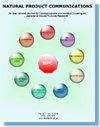利用靶向代谢组学研究番木瓜叶片成熟过程中的类黄酮变异及其与性分化的关系
IF 1.4
4区 医学
Q4 CHEMISTRY, MEDICINAL
引用次数: 0
摘要
背景木瓜(Carica papaya L.)是一种雌雄异株植物,其叶片因含有丰富的植物化学物质(包括类黄酮)而具有药用和营养价值。本研究旨在探讨木瓜叶片中黄酮类化合物在不同成熟阶段的变化以及性别差异对这些化合物积累的影响。方法采用超高效液相色谱-串联质谱法同时定量检测木瓜叶片中的6种黄酮类化合物(莽草素、木犀草素、芦丁、烟花素、槲皮素和异鼠李素)。结果与老叶相比,嫩枝和嫩叶中黄酮类化合物的浓度明显更高。此外,通过分层聚类分析,还观察到雌雄植株的类黄酮组成存在明显差异,尤其是在嫩叶中。对黄酮类化合物含量的进一步分析表明,花蒂素、烟花素和芦丁可作为区分成熟阶段和性别的化学标记。本文章由计算机程序翻译,如有差异,请以英文原文为准。
Flavonoid Variability in Carica papaya L. var. Sekaki Leaf Maturation and Its Association With Sexual Differentiation Using Targeted Metabolomics
BackgroundCarica papaya L. is a dioecious plant with leaves known for their medicinal and nutritional value due to their rich phytochemical content, including flavonoids. Phytochemical variability arising from plant maturity and sex differences may influence the bioactivity of the plant.ObjectivesThis research aims to investigate the variations of flavonoids in C. papaya leaves across different maturation stages and the impact of sex differences on the accumulation of these compounds.MethodsAn ultra-high performance liquid chromatography–tandem mass spectrometry method was developed to quantify 6 flavonoids (manghaslin, clitorin, rutin, nicotiflorin, quercetin, and isorhamnetin) in the leaves simultaneously. The acquired data were further analyzed using chemometric tools.ResultsSignificantly higher concentrations of flavonoids were observed in shoots and young leaves in comparison to older leaves. Furthermore, distinct variations in flavonoid composition between male and female plants were also observed, especially in young leaves, as evidenced by hierarchical clustering analysis. Further analysis of flavonoid content indicates that clitorin, nicotiflorin, and rutin could serve as chemical markers to differentiate maturation stages and sexes.ConclusionThe study revealed significant variations in flavonoid concentrations during leaf development and between male and female plants, highlighting the importance of understanding these differences for unlocking the full potential of C. papaya leaves in medical and nutritional applications.
求助全文
通过发布文献求助,成功后即可免费获取论文全文。
去求助
来源期刊

Natural Product Communications
工程技术-食品科技
CiteScore
3.10
自引率
11.10%
发文量
254
审稿时长
2.7 months
期刊介绍:
Natural Product Communications is a peer reviewed, open access journal studying all aspects of natural products, including isolation, characterization, spectroscopic properties, biological activities, synthesis, structure-activity, biotransformation, biosynthesis, tissue culture and fermentation. It covers the full breadth of chemistry, biochemistry, biotechnology, pharmacology, and chemical ecology of natural products.
Natural Product Communications is a peer reviewed, open access journal studying all aspects of natural products, including isolation, characterization, spectroscopic properties, biological activities, synthesis, structure-activity, biotransformation, biosynthesis, tissue culture and fermentation. It covers the full breadth of chemistry, biochemistry, biotechnology, pharmacology, and chemical ecology of natural products.
Natural Product Communications is a peer reviewed, open access journal studying all aspects of natural products, including isolation, characterization, spectroscopic properties, biological activities, synthesis, structure-activity, biotransformation, biosynthesis, tissue culture and fermentation. It covers the full breadth of chemistry, biochemistry, biotechnology, pharmacology, and chemical ecology of natural products.
 求助内容:
求助内容: 应助结果提醒方式:
应助结果提醒方式:


